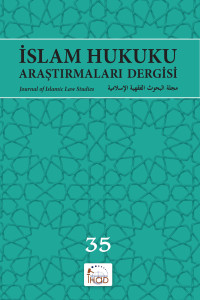Abstract
Shâree (Şari) ‘Allah SWT, declared His intentions through His last book, the Qur’an, and the last messenger Prophet Muhammad (pbuh). Therefore, the Qur’an and Sunnah are actually the source of beyan. However, in the history of fıqh method there basically came out of two ecoles which are related to how the Qurân itself and Prophet Muhammad’s sunnahs stated. The first of these is the school represented by Hanafi methodologists called Fukahâ. The second is the school represented by Cumhûr who is called Mütekellimin. This article is based on the epistemology of the ban theory represented by Hanafis. The Hanafi methodologists, who accept the ban as a “İzhâr (Disclose)” operation, not “ Zuhur (Occurrence)”, examine it with five classifications, namely, takrîr (declaration), tafsîr (exegesis), taghyîr (alteration), tebdîl (translation) and ve zarûret (obligatory). There are the five declaration theories in the Hanafi Methodology; beyân’-takrîr (declaration- statement) in terms of giving strength to the word by eliminating the possibilities of the metaphors and issues in the word, beyân’-tafsîr (declaration- exegesis) in terms of eliminating the closedness of the closed word and clarifying it, beyân’ı-tağyîr (declaration- alteration)by connecting the beginning and the end of the word with a view to bringing a holistic meaning, beyân’-tebdîl (declaration-translation) in terms of partial or complete elimination of the previous word’s verdict with a subsequent word and beyân’ı-zarûret (declaration- obligatory) by saying that a word in need is explained in a way that is not deemed in terms of language rules. According to this theory, there are no words that are not explained or understood in the two main sources of Islam, the Qur’an and Sunnah nasses. Again, according to this theory, Shari ‘Allah Teâla has explicitly explicitly the Qur’an and Sunnah for his servants, whose maqam is obliged by his address.
Abstract
Şâri’ Allah Teâla, makâsıdını son Kitâb’ı Kur’ân ve son elçisi Hz. Muhammed (s.a.s.) üzerinden beyân etmiştir. Dolayısıyla Kur’ân ve Sünnet beyân’ın bizâtihi kaynağıdır. Ancak Kur’ân’ın, kendisini ve Hz. Peygamber’in (s.a.s.) Sünnet’inin Kur’ân’ı nasıl beyân ettiği ile ilgili olarak Fıkıh usûlü tarihinde temelde iki ekol ortaya çıkmıştır. Bunların ilki, adına Fukahâ denilen Hanefî usûlcülerin temsil ettiği ekoldür. İkincisi de adına Mütekellimîn denilen Cumhûr’un temsil ettiği ekoldür. Bu makalemiz, Hanefîlerin temsil ettiği beyân teorisinin epistemolojisi üzerine kurulmuştur. Beyânı “zuhûr” değil, bir “izhâr” ameliyesi olarak kabul eden Hanefî usûlcüler, onu takrîr, tefsîr, tağyîr, tebdîl ve zarûret olmak üzere beşli bir tasnifle incelerler. Sözdeki mecâz ve husûs ihtimallerini ortadan kaldırarak söze kuvvet kazandırması yönüyle beyân’ı-takrîr, kapalı olan sözün kapalılığını ortadan kaldırarak onu açıklığa kavuşturması yönüyle beyân’ı-tefsîr, sözün başı ile sonunu birbirine bağlayarak bütüncül bir anlam ortaya çıkarması yönüyle beyân’ı-tağyîr, sonraki bir sözle önceki sözün hükmünün kısmen veya tamamen ortadan kaldırılması yönüyle beyân’ı-tebdîl, izâha muhtaç bir sözün aslında dil kuralları açısından izâh sayılmayan bir tarzda izâh edilmesi yoluyla beyân’ı-zarûret Hanefî usûlü’nün beşli beyân teorisidir. Bu teoriye göre İslâm’ın iki ana kaynağı olan Kur’ân ve Sünnet nass’larında açıklanmayan veya anlaşılmayan hiçbir söz yoktur. Yine bu teoriye göre Şâri’ Allah Teâla, makâsıdını şer’î hitabıyla mükellef tuttuğu kulları için Kur’ân ve Sünnet bütüncüllüğü üzerinden izhâr etmiştir.
Keywords
Details
| Primary Language | Turkish |
|---|---|
| Subjects | Religion, Society and Culture Studies |
| Journal Section | Research Articles |
| Authors | |
| Publication Date | April 30, 2020 |
| Submission Date | November 1, 2019 |
| Published in Issue | Year 2020 Issue: 35 |



